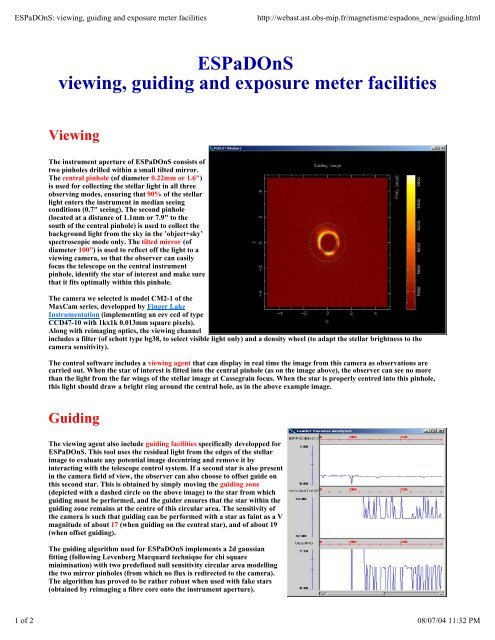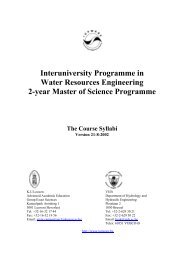CFHT operating manual - Homepage Usask
CFHT operating manual - Homepage Usask
CFHT operating manual - Homepage Usask
Create successful ePaper yourself
Turn your PDF publications into a flip-book with our unique Google optimized e-Paper software.
ESPaDOnS: viewing, guiding and exposure meter facilities http://webast.ast.obs-mip.fr/magnetisme/espadons_new/guiding.html<br />
ESPaDOnS<br />
viewing, guiding and exposure meter facilities<br />
Viewing<br />
The instrument aperture of ESPaDOnS consists of<br />
two pinholes drilled within a small tilted mirror.<br />
The central pinhole (of diameter 0.22mm or 1.6")<br />
is used for collecting the stellar light in all three<br />
observing modes, ensuring that 90% of the stellar<br />
light enters the instrument in median seeing<br />
conditions (0.7" seeing). The second pinhole<br />
(located at a distance of 1.1mm or 7.9" to the<br />
south of the central pinhole) is used to collect the<br />
background light from the sky in the ’object+sky’<br />
spectroscopic mode only. The tilted mirror (of<br />
diameter 100") is used to reflect off the light to a<br />
viewing camera, so that the observer can easily<br />
focus the telescope on the central instrument<br />
pinhole, identify the star of interest and make sure<br />
that it fits optimally within this pinhole.<br />
The camera we selected is model CM2-1 of the<br />
MaxCam series, developped by Finger Lake<br />
Instrumentation (implementing an eev ccd of type<br />
CCD47-10 with 1kx1k 0.013mm square pixels).<br />
Along with reimaging optics, the viewing channel<br />
includes a filter (of schott type bg38, to select visible light only) and a density wheel (to adapt the stellar brightness to the<br />
camera sensitivity).<br />
The control software includes a viewing agent that can display in real time the image from this camera as observations are<br />
carried out. When the star of interest is fitted into the central pinhole (as on the image above), the observer can see no more<br />
than the light from the far wings of the stellar image at Cassegrain focus. When the star is properly centred into this pinhole,<br />
this light should draw a bright ring around the central hole, as in the above example image.<br />
Guiding<br />
The viewing agent also include guiding facilities specifically developped for<br />
ESPaDOnS. This tool uses the residual light from the edges of the stellar<br />
image to evaluate any potential image decentring and remove it by<br />
interacting with the telescope control system. If a second star is also present<br />
in the camera field of view, the observer can also choose to offset guide on<br />
this second star. This is obtained by simply moving the guiding zone<br />
(depicted with a dashed circle on the above image) to the star from which<br />
guiding must be performed, and the guider ensures that the star within the<br />
guiding zone remains at the centre of this circular area. The sensitivity of<br />
the camera is such that guiding can be performed with a star as faint as a V<br />
magnitude of about 17 (when guiding on the central star), and of about 19<br />
(when offset guiding).<br />
The guiding algorithm used for ESPaDOnS implements a 2d gaussian<br />
fitting (following Levenberg Marquard technique for chi square<br />
minimisation) with two predefined null sensitivity circular area modelling<br />
the two mirror pinholes (from which no flux is redirected to the camera).<br />
The algorithm has proved to be rather robust when used with fake stars<br />
(obtained by reimaging a fibre core onto the instrument aperture).<br />
1 of 2 08/07/04 11:32 PM

















